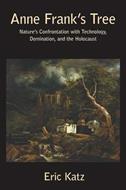L’articolo è stato aggiunto alla lista dei desideri
IBS.it, l'altro eCommerce
Anne Frank's Tree: Nature's Confrontation with Technology, Domination, and the Holocaust
Cliccando su “Conferma” dichiari che il contenuto da te inserito è conforme alle Condizioni Generali d’Uso del Sito ed alle Linee Guida sui Contenuti Vietati. Puoi rileggere e modificare e successivamente confermare il tuo contenuto. Tra poche ore lo troverai online (in caso contrario verifica la conformità del contenuto alle policy del Sito).
Grazie per la tua recensione!
Tra poche ore la vedrai online (in caso contrario verifica la conformità del testo alle nostre linee guida). Dopo la pubblicazione per te +4 punti
Altre offerte vendute e spedite dai nostri venditori



Tutti i formati ed edizioni
Promo attive (0)
In this important and original interdisciplinary work, well-known environmental philosopher Eric Katz explores technology's role in dominating both nature and humanity. He argues that technology dominates, and hence destroys, the natural world; it dominates, and hence destroys, critical aspects of human life and society. Technology causes an estrangement from nature, and thus a loss of meaning in human life. As a result, humans lose the power to make moral and social choices; they lose the power to control their lives. Katz's argument innovatively connects two distinct areas of thought: the fundamental goal of the Holocaust, including Nazi environmental policy, to heal the degenerate elements of society; and the plan to heal degraded natural systems that informs the contemporary environmental policy of 'ecological restoration'. In both arenas of 'healing', Katz argues that technological forces drive action, while domination emerges as the prevailing ideology. Katz's work is a plea for the development of a technology that does not dominate and destroy but instead promotes autonomy and freedom. Anne Frank, a victim of Nazi ideology and action, saw the titular tree behind her secret annex as a symbol of freedom and moral goodness. In Katz's argument, the tree represents a free and autonomous nature, resistant to human control and domination. Anne Frank's Tree is rooted in an empirical approach to philosophy, seating complex ethical ideas in an accessible and powerful narrative of historical fact and deeply personal lived experience. The book is essentially a meditation on the opposing themes of domination and autonomy as they relate to the uses of technology in environmental policy and in the genocidal policies of the Holocaust. Rather than an abstract, or theoretical, examination of the concepts of 'domination' and 'autonomy,' the book undertakes a robust pragmatic investigation into the ways in which these themes 'cash-out' in specific real-life or historical situations. It is a work in 'empirical' or 'historical' philosophy, for the meaning of the philosophical ideas and the arguments used to justify them flow out of a detailed understanding of historical and practical reality as well as personal lived experience. The overall argument of the book is this: There is a connection between the destruction of nature and the destruction of specific human cultures, although this connection is not often perceived or understood. The analysis of environmental problems dealing with the degradation of natural systems is generally seen as distinct from the analysis of human historical problems such as war, imperialism, and genocide. But on the level of practical or physical reality, it can be seen that science and technology plays a significant and crucial role in this connection; moreover, on the conceptual level, the ideology of domination and control is the connecting theme. By the examination of several case studies or historical examples, we can see the pervasive power of the idea of domination expressed through the development and use of science and technology. Technology dominates, and hence destroys the natural world; it dominates, and hence destroys, critical aspects of human life and society. In this realm of technological domination, humans lose the power to make moral and social choices; they lose the power to control their lives. To avoid or overcome this evil of domination, we must turn to the ideas of autonomy and freedom as our primary goals of the development and use of technology. Anne Frank's tree can serve as a symbol of the resistance to domination and oppression and the need for the preservation of freedom and autonomy both in human society and in the natural world.
L'articolo è stato aggiunto al carrello
Le schede prodotto sono aggiornate in conformità al Regolamento UE 988/2023. Laddove ci fossero taluni dati non disponibili per ragioni indipendenti da IBS, vi informiamo che stiamo compiendo ogni ragionevole sforzo per inserirli. Vi invitiamo a controllare periodicamente il sito www.ibs.it per eventuali novità e aggiornamenti.
Per le vendite di prodotti da terze parti, ciascun venditore si assume la piena e diretta responsabilità per la commercializzazione del prodotto e per la sua conformità al Regolamento UE 988/2023, nonché alle normative nazionali ed europee vigenti.
Per informazioni sulla sicurezza dei prodotti, contattare productsafetyibs@feltrinelli.it
L’articolo è stato aggiunto alla lista dei desideri

